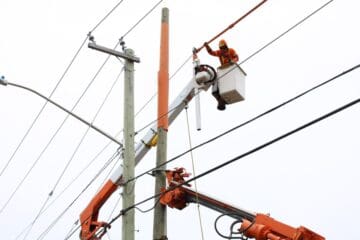Carbon Capture, Aggressive Reforestation, and our Current Energy Mix
There can be little doubt that the effects of climate change are being are being felt by us today. We are constantly being notified of triple digit temperatures and droughts in areas unfamiliar with such extreme heat, coupled with damaging weather events occurring with more frequency and intensity.
Amping up renewable energy sources like solar, geothermal, hydro & wind power to ensure that we decrease our present & future output of CO² is crucial, but what many people forget is that we must also address the emissions already in the atmosphere. That’s where “Carbon Capture” comes in: technologies aimed at capturing and removing carbon dioxide from the atmosphere. As you can imagine, this is no easy task. Nevertheless companies across the world are working, as we speak, on developing technology to address this problem.
Here are some examples: Charm Industrial has created a means of capturing CO² gas in a molasses type of goop which then can be pumped into bedrock caverns permanently sequestering the carbon. Another innovative approach in place is the growing trend to place CO² gas into building materials, particularly concrete. Carbon Cure and Carbon Built are already using this technology in over 500 plants worldwide, with an overall goal of 500 million tons of reduction by 2030.
Prize Money for Carbon Capture Excellence
For anyone that wants to jump into the game, Elon Musk is offering an unprecedented $100 Million prize to any entity that is able to demonstrate CO² removal – from either ocean or atmosphere- 1,000 tons annually, while modelling the cost of removal at the million ton per year scale, then presenting a plan to sustainably reach future gigaton-per-year removal. Carbon Cure and Carbon Built have already won smaller prize amounts from various carbon competitions, but if they could dial up their operations they could have a shot at living the life of the eccentric space-racers.
Why this massive scale? According to the International Panel on Climate Change (IPCC) which did an in-depth report on the subject, we need to be removing a sustained 10 gigatons of carbon dioxide per year by 2050 in order to hit the current target of 1.5-2° C above pre-industrial global average temperature. We are currently on the path to hit 6° +C by 2100 which would wipe out countless species and ecosystems globally. No pressure.

Carbon Sequestration in All Forms
While cleaning up CO² is a key component to reducing our alarming greenhouse gas (GHG) levels, more must be done to eliminate the discharge of CO² to begin with. Exxon Mobil agrees that this kind of PR is worthy of some investment. In fact, if you google ‘carbon capture’ Exxon Mobil- Carbon Capture & Storage is the first thing that pops up in the paid ad section atop the search engine return page (SERP). SEO is a cinch when you have money to burn on trying to clean up your image.
My colleague Meagan attended a Climate Restoration forum at the United Nations building in New York at the end of 2019. The subject matter was how do we clean up what we’ve already emitted? People from every continent attended, talking about solutions they are working in on their communities. One theme that was reiterated consistently throughout the forum, and was memorably emphasized by the Deputy Secretary of United Nations Environmental Program (UNEP), was that our best carbon sequestration tool is the most simple- trees. Colossal reforestation efforts are taking place across the globe: the trillion tree campaign (aiming to plant one trillion trees globally by 2030), Pakistan’s Ten Billion Tree Tsunami Project (an ambitious plan to plant 10 billion trees by 2023) and the 8 Billion tree campaign (that runs a massive replanting operation in the Amazon rainforest). The state of Maryland, in an effort to do its part, passed a bill aiming to plant 5 million trees by 2030. On top of the reforestation emphasis, carbon capture was also discussed as an additional effort to what was already being done, because in order to save everything, we need everyone.
Read Also:
Why We Need a New Green Infrastructure
In this context, and considering what is happening with our greenhouse gas levels, the framing of a green energy switch over may be a little more clear- not only do we need to make the switch quickly to non-emitting forms of energy, but we need to aggressively remove the emissions we have already released. Although renewables are gaining globally on dirtier forms of energy, the answer of “Is it fast enough?” will always be “No” when you’re already in the proverbial red. According to the U.S. Energy Information Administration, the country’s energy sourcing in 2020 was as follows:
Petroleum 35%
Natural gas 34%
Renewables 12%
Coal 10%
Nuclear 9%
Of the renewables, 39% was from biomass; 26% wind; 22% hydroelectric; 11% solar and 2% geothermal.
The Myth of Clean Natural Gas
Although for a while natural gas was marketed to the average American consumer as a clean form of energy, the extraction, storage, transportation and distribution of this energy fuel allows the release of methane, a stronger greenhouse gas that remains in the atmosphere for a much shorter period of time (a decade as opposed to over a century for carbon dioxide) but does its damage more quickly.
About 30% of global warming effects are currently caused by methane alone. Just this past May, the Climate & Clean Air Coalition (CCAC) in coordination with UNEP released a Global Methane Assessment showing that if readily available solutions to methane emissions can be implemented immediately, up to 45% of human-caused emissions can be curbed by 2030. A majority of these measures – 60%- are low cost while a stunning 50% are negative cost, meaning if companies take action to say, repair leaks in their fossil fuel infrastructure they will net gain from the action.
Moving Forward
Assuming someone will win the coveted Musk prize, and starts making a dent in decreasing the atmospheric or oceanic carbon, the efforts must not only be coupled with but preceded by a halt to releasing the greenhouse gases in the first place.
Zero-emission energy is the sourcing not only of the future, but of the present so that we may have that future unmarred by the hints of the extremes we are already seeing.
Death Valley hit 130 degrees this week.
We are the first generation to see the effects of climate change and the last one to be able to do anything about it. The technology is here, and we are ready to help you implement it. Calculate what your impact can be using the EPA’s Greenhouse Gas Equivalencies calculator. Enter your annual usage & select the option from the pull down menu (enter kilowatt-hours of electricity for building usage) to see what your emission prevention can be when you switch to clean energy. Aurora offers no-cost commercial solar quotes, enter your property’s address and we can have a preliminary design to you in 12 business hours.
Photo credit: Anthony Aird






